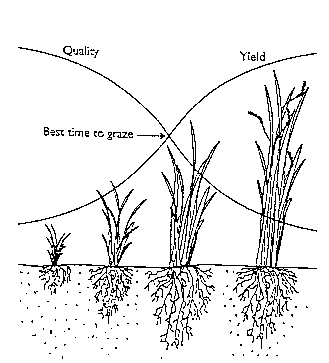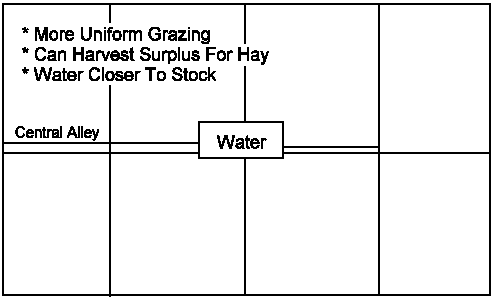Getting Started with Intensive Grazing
Table of Contents:
- Why Intensive Grazing?
- How Do Pastures Grow?
- Grazing Habits of Livestock
- Forage Needs
- Planning Process
- Paddock Layout
- Gates and Alleys
- Location of Water
- Handling Facilities
- Further Reading
Why Intensive Grazing?
There are many reasons why producers move to intensive grazing systems. These include:
- potential to grow more forage
- higher stocking rates
- better cattle management
- extend the grazing season
- better use of forage quality
- less machinery required
- More $$ return to land base
How Do Pastures Grow?
A good understanding of how grasses grow is necessary to understand the dynamics of a pasture system. Pasture growth is quite different compared to a harvested forage system due to the selective grazing of the animal and the seasonality of growth of different forages in a pasture system.

Figure 1
The seasonal growth pattern of most forages is well known (Figure 1):fast growth in the early part of the growing season, slow growth in the later part of the season. Balancing the forage needs of the livestock is both an `Art and a Science' for the grazing manager. Intensive management promotes forage recovery after grazing and timing the grazing before the plant becomes too mature by adjusting the grazing and rest periods and in some situations, harvesting the surplus for hay.
A Rest/Recovery system of grazing is necessary to maintain root reserves and promote vigorous growth.
Grazing Habits of Livestock
Livestock are selective grazers, using their sense of smell to select the most desirable plants. With uncontrolled grazing, they will always return to the most recent regrowth and if allowed to continue, will overgraze these plants resulting in loss of the most desirable plant species.
Livestock may vary in their ability to eat pasture forages. However, by regulating the grazing time (days) and the time (days) for regrowth, it is possible to vary the height of the forage and thus achieve the optimum bite size for the grazing animal.
For cattle, 4-8 inches is consideredan ideal grazing height, as an animal can obtain a good mouthfull of forage with each bite. Forage over 10 inches is considered too high, as it is difficult for the animal to obtain a good mouthful. Plants less than 3 inches in height will not provide a good mouthful.
Forage Needs
Cow/calf pairs require different quality and quantity of forage than do stocker or feeder animals. A cow/calf unit can make good use of low quality forage while stockers need higher quality. Forage demands are often determined as a percent of body weight. A range of 2.5 per cent to 4 per cent of body weight (BW) is often used for beef animals to account for maintenance, growth and feed wastage.
Stocking rates may be determined in this manner. For example, a 1500 lb. cow/calf pair at 4 per cent of BW may require 60 lbs. of dry matter (DM) forage per day or 3.75 tons DM for the season (125 days). A pasture capable of producing 3,000 lbs. of DM for the season, would require 2.5 acres for that grazing unit.
Sheep are similar in their forage requirements to cattle and horses. Due to a more inefficient digestive system they usually requires 15 per cent to 25 per cent more forage. Goats browse different species and are often used in multiple species grazing systems to make better use of the available forages including weeds and brush.
Stocking rates should always be conservative and be continuously monitored to avoid lack of supply during times of drought.
Measuring or estimating the available forage in a pasture is the "Art" of the grassland manager. Some tools, such as a pasture disk, are available to estimate available forage.
Planning Process
1. Pasture Plan
To plan a grazing system for your pasture, you need a map or sketch of the existing farm enterprise so that you can plan for the future.
On your sketch you will need the location of :
- Existing fields, (crop and pasture)
- Location of bush, streams, ditches, slopes, roads
- Location of all existing fences
- Location of old and new water sites
Aerial photos are very useful to provide an accurate picture of the topography as well as the acres involved in each parcel.
2. Pasture Quality and Quantity
Identify the quality of forage in all pasture areas and potential pasture areas. Include seeded pasture, unimproved and bush pasture, seeded annuals, and crop residues that could be pastured.
The next step is to estimate the potential productivity and the time when the forage is available. This can be done by estimating the potential forage production (by measurement or from a reference source) and converting this information to Animal Days per Acre or Animal Unit Months (A.U.M.). Both systems are based upon an animal unit of 1,000 lbs. live weight.
If you assume 1 A.U. will consume 26 lbs. of DM per day (2.6 per cent of BW), the forage needs of one cow/calf pair will be 26 lbs. DM/day. A pasture rated at 5 AUM could support 1 AUM for 5 grazing months.
3. How Many Paddocks
There is no "ideal number" of paddocks in a grazing system. The number of paddocks required in any grazing unit will depend upon the number of grazing days in a period and the amount of rest required for plant recovery. More paddocks will increase the control of the grazing animal, increase the stock density and reduce selective grazing.
Rest Period/Grazing Period + No. Animal Groups = #Paddocks
Using this formula, if 30 days are required for regrowth, 5 days grazing per period and 1 herd, this would require 7 paddocks. For two herds, an additional paddock would be required assuming a "follow the leader" grazing system.
Days grazing per period is varied according to size and quality of forage in a paddock. For example, more days grazing per paddock for larger paddocks or those with tame forages and less days for bush or native pastures or smaller paddocks.
Rest is the Key to grazing management. Sufficient time must be provided for the grazed plant to recover before another grazing. The grazing manager is always looking ahead to when the grazed paddocks will be ready for another grazing. Walk Your Pastures. It usually takes a plant 20-40 days to recover from a grazing.
During the fast growing period of the season, 20 days or less may be required for regrowth, however 40 or more days may be required during the slow growth periods. Many tame forages will recover faster than some native species.
4. Stock density
Stock density is the number of animals per acre in a single paddock during a grazing period. For example, 50 head on 10 acres provides a stock density of 5 head/acre.
Varying the size of the paddocks will affect the stock density. Some grazing managers with many paddocks prefer stock density of 20 head per acre or more to give greater control.
Increasing the stock density on a pasture results in more uniform grazing, a more even "clip" of the pasture as the selective grazing of the pasture is reduced.
Paddock size is determined by:
Number of Animals Desired Stock Density
5. Variable Stock Density
With the seasonal growth curve of the pasture and the increasing demand of the livestock during the season, varying the size, and the numbers of paddocks in a grazing system is a common practice. The objective is to maintain the forage in a high-quality vegetative state.
The fencing system, particularly temporary electric fencing, is used to vary the size of the paddock. One option is to have a good perimeter fence and then use temporary electric fencing to subdivide or "ration out" the required forage for the stock.
Paddock Layout
Paddocks can be of any size and shape in a grazing system. It is preferable to lay out fence lines along contours where possible. All native forages should be fenced separately from seeded forages. Consider developing some sacrifice areas for use in wet periods.

Figure 2
It is suggested that for cattle, paddocks should be as square as possible for more even grazing and to have good manure distribution (figure 2). These paddocks are also easier to harvest surplus for hay or silage. Long narrow paddocks will result in excessive grazing and manure near the water source, with undergrazing at the far ends of the paddock. Horses prefer longer paddocks for exercise (figure 3).

Figure 3
To reduce selective grazing, arrange paddocks where possible according to forage quality (figure 4).

Figure 4
Gates and Alleys
A well planned pasture requires a quick and easy system of moving livestock between paddocks. The animals should be trained to be led by a "boss cow", by calling, or by the use of a cow bell.
Alleys are used to tie paddocks together, however, they should be as short as possible as up to 15 per cent of the manure may be deposited in the alley. Alleyways should be at least 20 ft wide and have at least two and preferably three wires. Try to avoid sharp corners.
Do not plan to move machinery for hay harvesting on the alleys, driving through the paddock over the single cross fence wire is a more practical alternative.
The alley way surface should be firm and well drained where possible to reduce foot rot problems. Access over soft or wet areas should be constructed especially if you plan to check your animals with a truck.
Gates should be placed in the direction of the water source or the usual flow of traffic and always in the corner of the paddock. Take some time to plan the location of the gates, it will save many hours of trying to force livestock where they don't want to go.
Location of Water
Livestock will travel in excess of one mile for water. When they come to the water site as a total herd, they will spend more time in that area, causing a build up of manure and overgrazing of the forage around the site.
However, if the water source is located within 800 ft, they will come to water on an individual basis and not as the total herd. Smaller waterers may be used and more of the manure will be deposited on the pasture and not in the alley or around the waterer.
Use of PVC pipe to move water to the desired location is often the most economical option, even up to distances of one mile.
Raised storage tanks can provide the on-site storage and water pressure for most water systems. High volume, low pressure float systems for 1.25 inch hoses are now readily available for use in water troughs.
Handling Facilities
Always plan handling facilities that are suited for all weather conditions. The corral should be used as a watering source some time during the season so that the animals will be familiar with it.
The corral should be big enough to contain all the animals in preparation for shipping (25 sq. ft. per head). This is the holding area only, additional space is required for the chute and working corrals.
These are only a few aspects of developing a grazing system. Reference sources for further reading are listed below, however, the best teacher is experience - So Go Do It!!
Further Reading
Greener Pastures On Your Side Of The Fence - Bill Murphy
Quality Pasture - Alan Nation
Intensive Grazing Management - Burt Smith
Manitoba Grazing Reference Manual

